Haryana Board Class 8 Maths Geometry Chapter 5 Relation Between Two Sides Of A Triangle And Their Opposite Angles
Question 1. If the measurement of the angle of an isosceles triangle is low, then find the measurement of the other two angles.
Solution:
The Sum of two acute angles is (180°-105°)
or 75°
Let ∠A = 105° and AB = AC
∴ \(\angle B=\angle C=\frac{180^{\circ}-105^{\circ}}{2}=\frac{75^{\circ}}{2}=37.5^{\circ}\)
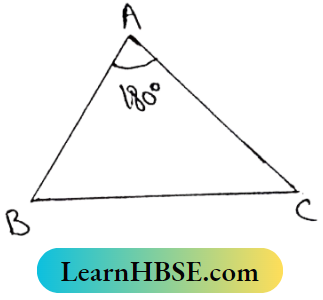
Question 2. In an Isosceles triangle one angle of the base is 550, then find the measurement of the Vertical angle.
Solution:
In an isosceles triangle, one angle of the base is 55°.
The other angle of the base is 55°.
Then the vertical angle is 180°- (55°+ 55°) = 180°-110°= 70°
What is the relation between two sides of a triangle and their opposite angles?
Question 3. In the adjacent figure, in ΔABC, AB = AC, If ∠A+∠B = 115°, find the measurement of ∠A.
Solution:
In ΔABE, ∠A + ∠B + ∠C = 180°
115° + ∠C = 180°
⇒ ∠C = 180° = 115°
⇒ ∠C = 65°
As AB = AC
∴ ∠B = ∠C = 65°
∠A = 115°-65° = 50°
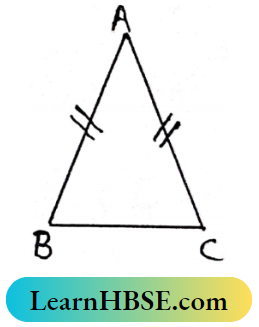
Question 4. Two line Segments AB and CD bisect each other at 0; If AC = 4cm, then find the length of BD.
Solution:
In ΔAOC and ΔBOD,
OA = OB, OC = OD
and ∠AOC = ∠BOD (vertically Opposite angle)
∴ ΔAOC ≅ ΔBOD (by AAS Congruency)
∴ Ac = BP
4cm = BD
∴ The length of BD is 40m.
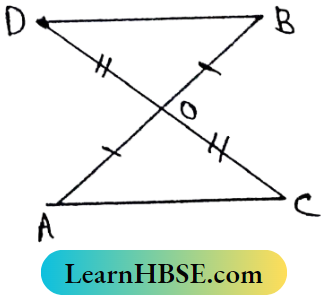
How to prove the relation between sides and angles of a triangle in Class 8 Maths?
Question 5. In an isosceles triangle, the vertical angle is three times each angle of the base. Find the measurement of the Supplementary angle of the Vertical angle.
Solution:
Let the measurement of each angle of the base be x°
∴ The measurement of the vertical angle is 37°
The sum of the three angles of a triangle is 180°.
∴ 3x°+x°+x° = 180°
⇒ 5x°=180°
⇒ \(x^{\circ}=\frac{180^{\circ}}{5^{\circ}}=36^{\circ}\)
∴ The Vertical angle Is (3×36°) or 180°
The Supplementary angle of the Vertical angle is (180°-108°) Or 72°.
Question 6. In ΔABC, AB=AC, The bisector of ∠ABC intersects AC at D. If ∠A=56°, then find the Value of ∠ABD.
Solution:
In ΔABC,
AB = AC
∴ ∠ABC = ∠ACB
∠BAC=560
In ΔABC,
∠BAC + ∠ABC + ∠ACB = 180°
56° + ∠ABC + ∠ABC = 180°
⇒ 2 ∠ABC = 180°-56°=124°
⇒ \(\angle A B C=\frac{124^{\circ}}{2}=62^{\circ}\)
As BD is the bisector of ABC.
∴ \(\angle A B D=\frac{1}{2} \angle A B C=\frac{1}{2} \times 62^{\circ}=31^{\circ}\)

Question 7. In ΔABC, AB = AC; BC is extended to D Such that AC=CD; if ∠ABC=70°, then find the value of ∠BAD.
Solution:
In ABC, AB=AC
∴ ∠ACB = ∠ABC = 70°
Again, ∠ACB + ∠ACD = 180°
70° + ∠ACD = 180°
⇒ ∠ACD = 180°-70°
⇒ ∠ACD = 110°
In ΔACD, AC= CD ∴ ∠DAC = ∠ADC
∠ACD + ∠ADC + ∠DAC = 180°
110° + ∠ADC + ∠ADC = 180°
2∠ADC = 180°- 110° = 70°
⇒ \(\angle A D C=\frac{70^{\circ}}{2}=35^{\circ}\)
In ∠ABD + ∠ADB + ∠BAD = 180°
i.e., ∠ABC + ∠ADC+ ∠BAD = 180°
70°+35°+ BAD = 180°
⇒ ∠BAD = 180°-105° = 75°
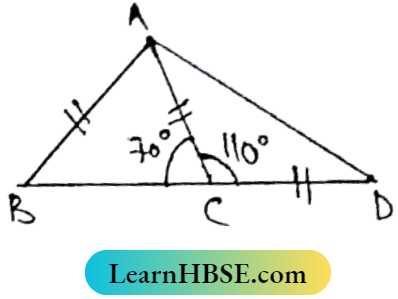
What is the theorem on the relation between sides and angles of a triangle?
Question 8. AB is the hypotenuse of the isosceles right-angled triangle ABC AD is the bisector of ∠BAC and AD intersects BC at D. Prove that AC + CD = AB.
Solution:
In the right-angled Isosceles triangle ABC, AB is the hypotenuse.
AD is the bisector of ∠BAC and AD Intersects BC at D.
Required to prove: Ac+CD = AB.
Construction: Through D I draw DC which is perpendicular to AB.
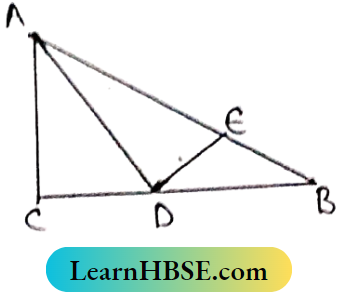
Proof: In ΔACD and ΔADE,
∠CAD = ∠EAD [as AD is the bisector of ∠BAC]
∠ACD = ∠AED = 90° [∵ DE ⊥ AB]
and AD is Common side.
∴ ΔACD ≅ ΔADE [by AAS Congruency)
∴ AC = AE [Corresponding Sides of Congwent triangles]
and CD = DE [Corresponding Sides]
In ΔABC, ∠ACB = 90° and AC = BC.
∴ ∠BAC = \(\angle A B C=\frac{90^{\circ}}{2}=45^{\circ}\)
In ΔBDE, ∠BED = 90°, B=45°
∴ ∠BDE = 180°-90° = 45° = 45°
∴ ∠BDE = ∠B ∴ BE = DE
Again CD = DE DE = CD = BE
AC+ CD = AE + BE = AB (Proved)
Question 9. Choose the Correct Answer:
1. In the adjacent figure, in ΔABC, which relation is correct?
- AB = BC
- AB = AC
- AC = BC
- AC ≠ BC
Solution:
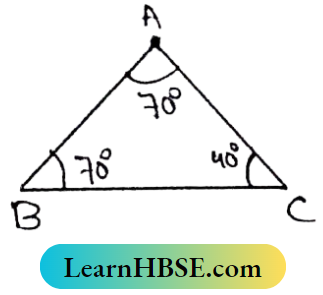
In ΔABC, ∠BAC = ∠ABC= 70°
∴ AC = BC (If the two angles of a triangle are equal then their opposite sides are equal)
So the Correct answer is (3).
What are the important theorems in Haryana Board Class 8 Maths Chapter 5?
2. In ΔABC, AB = AC; If ∠BAC = 70°, then the value of ∠ACB is
- 70°
- 110°
- 35°
- 55°
Solution:
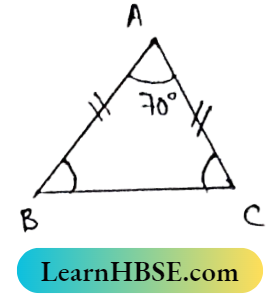
In ΔABC, AB = AC ∴ ∠ACB = ∠ABC.
Again, ∠BAC+ ∠ABC + ∠ACB = 180°
70° + ACB + ACB = 180°
⇒ 2∠ACB = 180°-70°
⇒ 2∠ACB = 110°
⇒ \(\angle A C B=\frac{110^{\circ}}{2}=55^{\circ}\)
So the correct answer is (4).
3. In the adjacent figure, in ΔABC, AB = AC and DE||BC; If ∠AED = 50°, then the value of ∠ABC is
- 50°
- 80°
- 100°
- 70°
Solution:
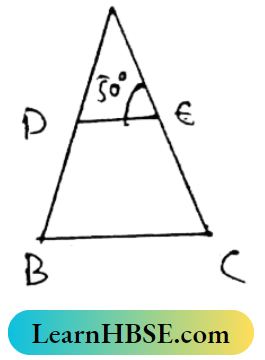
DE||BC and AC is transversal.
∴ ∠ACB = ∠AED (Corresponding angles) = 50°
In ΔABC, AB=AC ∴ ∠ACB = ∠ABC = 50° = ∠ABC.
So the correct answer is (1).
Question 10. Write ‘True’ and ‘False”.
1. The external bisector of the Vertical angle of an isosceles triangle is parallel to the base.
Solution: The Statement is true.
2. The Corresponding angles of two Congruent triangles are equal.
Solution: The statement is true.
How to solve Haryana Board Class 8 Geometry Chapter 5 problems step by step?
Question 11. Fill in the blanks:
1. The lengths of the hypotenuse of two _______ right-angled triangles are equal.
Solution: Congruent.
2. In an isosceles obtuse angle triangle the unequal angle is _________.
Solution: Obtuse angle
